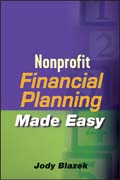
This Second Edition presents easy-to-implement strategies to make financial management a more streamlined, effective process in nonprofits of all types andsizes. It provides practical forms and checklists to aid nonprofit managers in managing their organizations' financial resources. It addresses five key areas of financial planning: general administration (tracking and reporting), roles and responsibilities of those involved (including staff, board members, andprofessional advisors), general budgeting (how to develop and implement a budget), strategies for managing and evaluating financial resources, and Internalcontrols to prevent fraud and abuse. INDICE: About The Author. Preface. Chapter One. Introductory Concepts. HowTo Use This Book. Attributes Of Nonprofits. Can Nonprofits Profit? Meaning OfProfit. Profit Prohibitions. Why Seek A Profit? Difference Between NonprofitsAnd For-Profits. Capitalization: Philanthropists Versus Investors. Revenues: Constituents Versus Customers. For-Profit Tools. Pursuit Of Financial Success:Some Observations. Be Realistic About Expectations. Make Use Of Intangible Resources. Nonprofit Mentality Is Often Penny Wise And Pound Foolish. Financial Accounting For Nonprofits Is Different. Producing An Audit Trail Benefits The Organization In Many Ways. Enhancing Computer Capabilities May Not Cure Financial Ills. Respect The Organizational Structure Or Change It. Know Who's In Charge. Economic Conditions Must Be Anticipated. Long-Range Planning Is Indispensable. Know Why The Nonprofit Organization Has Tax-Exempt Status. ComprehensiveFinancial Planning Checklist. Chapter Two. Structuring The Organization For Fiscal Strength. Establishing The Hierarchy. The Role Of The Board. Standards For Directors. Impact Of Sarbanes-Oxley. A Director's Duties. Reviewing Financial Reports. Filling Board Positions. Finding Prospects. Staff Representation On The Board. Compensation For Board Service. Number Of Directors. Role Of The Treasurer And The Cfo. Inside And Outside Accountants. Financial Management Team. Defining Inside And Outside Accountants. Selecting Financial Reporting Services. Understanding The Auditing Process. When To Audit. Review And Compilation Processes. Requests For Proposals For Accounting Services. Conflict-Of-Interest Policy. Chapter Three. Financing The Dream. Balancing Mission And Finances. Defining The Mission. Mission Statement. Prioritizing Goals. Assessing The Resources. Making Micro Resource Decisions. Macro Resource Analysis. Chapter Four. Budgeting. Budget Planning Issues. Balancing. Timing. Evolution. Accountability. Zero Basis Versus Incremental. Forecasting. Types Of Budgets. Advantages And Disadvantages. Who Participates In Budgeting? Selling The Budget. Budget Policy Manual. Communicating The Process. Scheduling Budget Process. Changing Budget Midyear. Timing Dilemmas. Preparing Forecasts. Donations And Memberships. Service Delivery Fees. Grants And Contracts. Investment Income. Expenses.Statistical Operational Data. Sample Customer Survey. Useful Statistics. Capital Additions Budget. Monitoring Variances. Model Budgets. Proposed Overall 20xx Budget Compared To 20xx Actual. Functional Revenue And Expense Budget. Member Services Budget Worksheet. Budget Increases (Decreases) Projected For 19x7.Personnel Budget. Program Cost Analysis. Other Reports And Analysis. A Budgeting Checklist. Chapter Five. Asset Management. Maximizing Resources. Getting Resources. Forming Alliances. Business Income. Planned Gifts. Cash Flow Planning. Understanding CPA's Cash Flow Statement. Cyclical Fluctuations. Designing Cash Flow Budgets. Beyond Cash Flow Imbalances. More Money In The Bank. To Borrow Or Not. Prudent Investment Planning. Facing The Unknown. Risk Versus Return. Investment Cycles. Measuring Investment Return. Restricted Gifts. Isolating Restricted Grants. Administrative Costs. Endowments. Who Gets The Appreciation? To Mark It To Market? How Income Is Measured. Endowment And Restricted Fund Checklist. Chapter Six. Nonprofit Accounting. What Is Accounting? Cash Receiving Systems. Cash Disbursement Systems. Payroll Disbursment System. Other Useful Ledgers And Financial Files. Fund Accounting. Computerized Accounts. Chart Of Accounts. National Standard. Functional Expense Categories. Why A Double Entry? Choosing A Method. Advantages Of Cash Method. Why Use The Accrual Method? Design Of The Financials. Fasb, Gaap And Nonprofits. Specific Standards For Nonprofits. Other Nonprofit Reporting. Internal Controls. Chapter Seven. SpecialFinancial Tools. Financial Indicators To Critique Performance. Economies Of Scale. Break-Even Analysis. Performance Statistics. Cost Accounting. TechniquesFor Capturing Costs. Cost Allocation Methods. Purchasing Procedures. ApprovalSystems. How Much Paper Work? Measuring Lifetime Cost. To Lease Or To Buy. Affiliations And Agency Agreements. Who's An Employee? Chapter Eight. Obtaining And Maintaining Tax-Exempt Status. Characteristics Of Tax-Exempt Organizations. Theoretical Basis For Exemption. Categories Of Exemption. Tax Deductibility.Understanding The Nonprofits Legal Form. Corporation. Trust. Unincorporated Association. Testing Suitability For Tax-Exemption. Why A New Nonprofit? What Category Of Exemption? How Is Money To Be Raised? Will Insiders Benefit? Where Will Assets Go? Maintaining Recognition Of Exempt Status. Role Of Internal Revenue Service. Forms 990. Other Filings. Bibliography. Index.
- ISBN: 978-0-471-71527-6
- Editorial: John Wiley & Sons
- Encuadernacion: Cartoné
- Páginas: 256
- Fecha Publicación: 05/03/2008
- Nº Volúmenes: 1
- Idioma: Inglés
